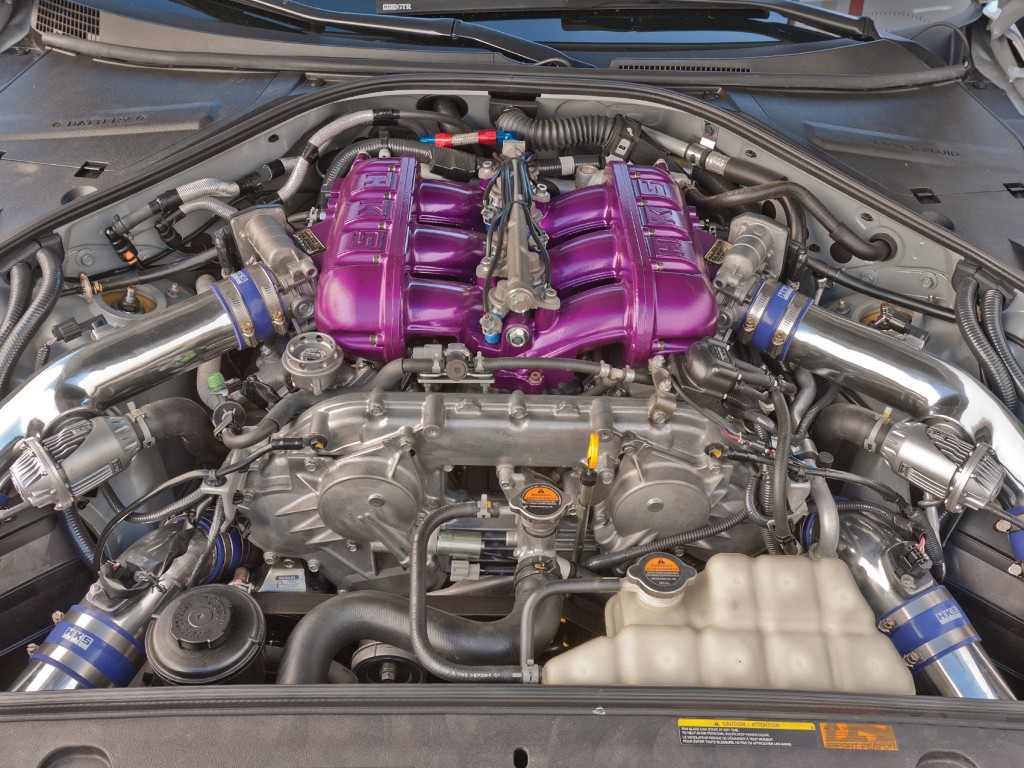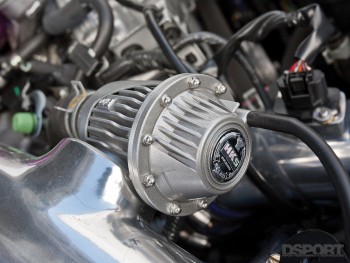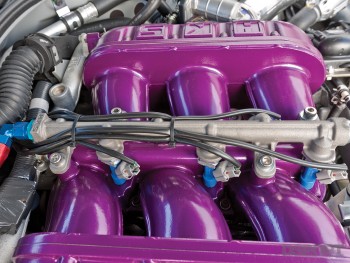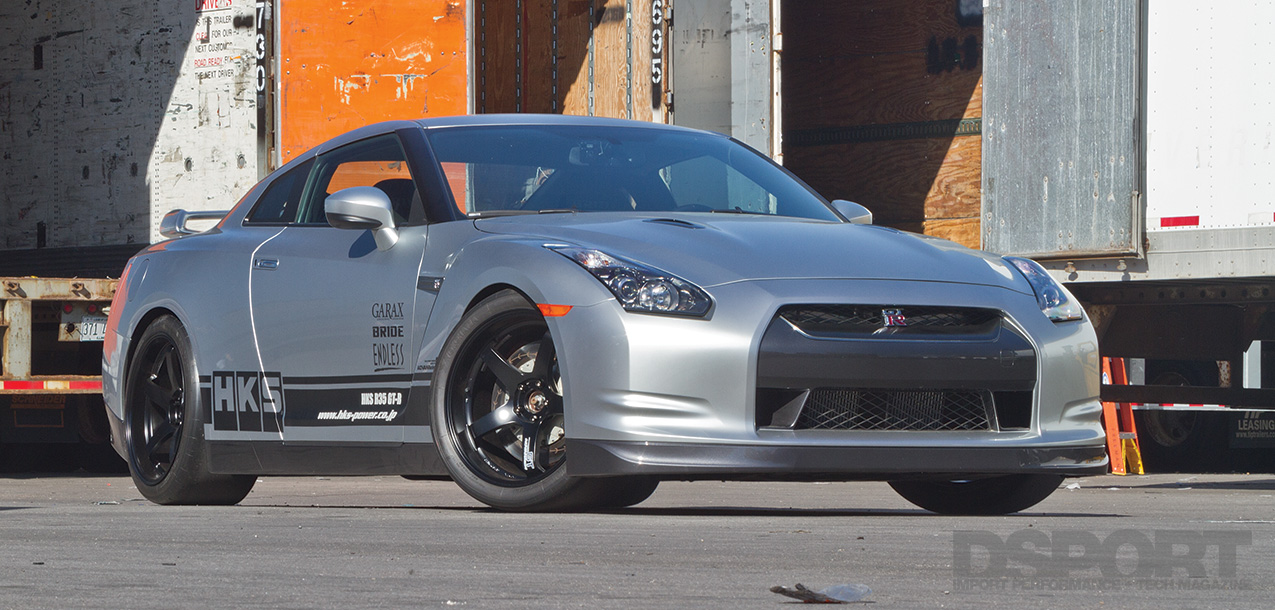DISPLACEMENT WITHIN THE COMFORT ZONE
 Unlike foreign performance tuners, most Japanese tuners prefer not to increase the engine displacement by increasing the bore size beyond what the factory cylinders or cylinder liners can accommodate. In the case of the VR38 block, its plasma sprayed cylinder walls cannot accommodate an overbore and would require sleeving if over boring is desired. However, JDM tuners have no problem increasing the stroke of an engine. Thus, HKS developed a 95.5mm billet steel stroker crankshaft, increasing the stroke by 7.1mm. With the bores unchanged, the stroked VR38 now displaced 4,104cc. HKS forged H-beam connecting rods join the stroker crank to the HKS forged aluminum 8.7:1 compression pistons. Up top, the cylinder heads remain largely unchanged, save for a stiffer set of HKS valve springs. HKS 270-degree intake cams and 278-degree exhaust cams actuate the valvetrain, providing 11mm of valve lift for increased volumetric efficiency.
Unlike foreign performance tuners, most Japanese tuners prefer not to increase the engine displacement by increasing the bore size beyond what the factory cylinders or cylinder liners can accommodate. In the case of the VR38 block, its plasma sprayed cylinder walls cannot accommodate an overbore and would require sleeving if over boring is desired. However, JDM tuners have no problem increasing the stroke of an engine. Thus, HKS developed a 95.5mm billet steel stroker crankshaft, increasing the stroke by 7.1mm. With the bores unchanged, the stroked VR38 now displaced 4,104cc. HKS forged H-beam connecting rods join the stroker crank to the HKS forged aluminum 8.7:1 compression pistons. Up top, the cylinder heads remain largely unchanged, save for a stiffer set of HKS valve springs. HKS 270-degree intake cams and 278-degree exhaust cams actuate the valvetrain, providing 11mm of valve lift for increased volumetric efficiency.
TWIN TERRORS
 The displacement increase of the VR38 permits the use of larger turbochargers for greater power potential without the compromise of turbo lag. HKS engineered its GTII 7867 and 7867R turbochargers as mirror images of one another, mated to the exhaust ports by way of HKS GT1000 manifolds. These turbochargers feature ball bearing center cartridges with 62mm inducers. Thus, the GT-II 7867 turbochargers should deliver enough boost to support over 500 horsepower each. To regulate boost pressure, each turbo relies on an HKS GT2 external wastegate controlled by an EVC6 electronic boost controller.
The displacement increase of the VR38 permits the use of larger turbochargers for greater power potential without the compromise of turbo lag. HKS engineered its GTII 7867 and 7867R turbochargers as mirror images of one another, mated to the exhaust ports by way of HKS GT1000 manifolds. These turbochargers feature ball bearing center cartridges with 62mm inducers. Thus, the GT-II 7867 turbochargers should deliver enough boost to support over 500 horsepower each. To regulate boost pressure, each turbo relies on an HKS GT2 external wastegate controlled by an EVC6 electronic boost controller.
BOOST DISTRIBUTION
 The boost generated by the turbochargers must be cooled before entering the combustion chambers, thus HKS designed a GT1000-spec front-mount intercooler to reduce the intake temperatures. Once the chilled air charge reaches the factory throttle bodies, it’s distributed to the intake ports by way of an HKS High-flow Intake manifold. Delivering greater volumes of air to the cylinders must be matched with additional fuel for proper combustion. HKS fortified the fuel delivery system with its Twin Injector Pro Kit, a dual injector setup composed of a dozen 575 cc/min fuel injectors. The dual fuel rail system receives 100 octane unleaded fuel from a pair of 195-lph in tank fuel pumps. HKS’ Yoshi Suzuki commented, “Using two injectors per cylinder greatly increases tuning flexibility while retaining OEM-like resolution.” Using an F-CON V Pro engine management to regulate the injectors, HKS engineers tuned the R35 for 29 psi boost pressure. The GT-R generated 997.8 horsepower and 873 lb-ft torque to the rollers of a Bosch AWD dynamometer.
The boost generated by the turbochargers must be cooled before entering the combustion chambers, thus HKS designed a GT1000-spec front-mount intercooler to reduce the intake temperatures. Once the chilled air charge reaches the factory throttle bodies, it’s distributed to the intake ports by way of an HKS High-flow Intake manifold. Delivering greater volumes of air to the cylinders must be matched with additional fuel for proper combustion. HKS fortified the fuel delivery system with its Twin Injector Pro Kit, a dual injector setup composed of a dozen 575 cc/min fuel injectors. The dual fuel rail system receives 100 octane unleaded fuel from a pair of 195-lph in tank fuel pumps. HKS’ Yoshi Suzuki commented, “Using two injectors per cylinder greatly increases tuning flexibility while retaining OEM-like resolution.” Using an F-CON V Pro engine management to regulate the injectors, HKS engineers tuned the R35 for 29 psi boost pressure. The GT-R generated 997.8 horsepower and 873 lb-ft torque to the rollers of a Bosch AWD dynamometer.


